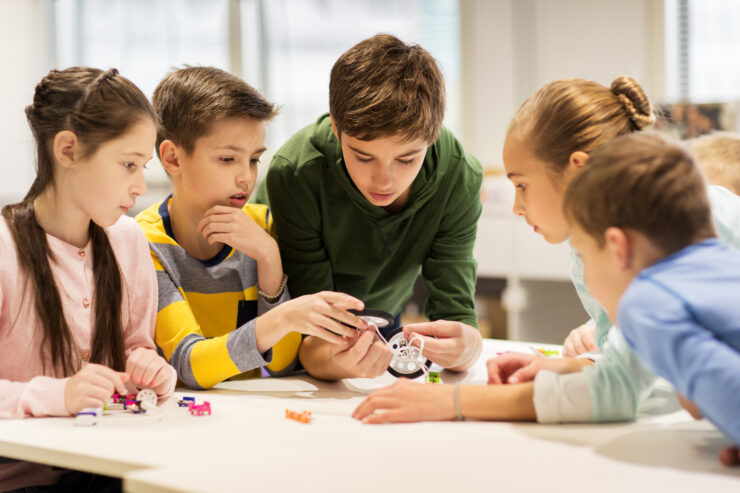Helping children learn from each other
The neuroscience behind peer-to-peer learning in the classroom

Many teachers use learning strategies that foster interaction between pupils. When the teacher’s explanations are repeated or further explained by a pupil to a ‘talking partner’, both pupils learn more. While interactions with adults are traditionally viewed as the primary drivers of learning, interactions between children, too, can foster learning, creativity, and other skills. Understanding the neuroscience behind the social dimension of learning can help teachers further harness this powerful strategy in the classroom.
The neural and cognitive development of learning from peers
Social skills, which are fundamental to interpersonal relationships, are supported by specific brain regions. As children grow into adolescents and then adults, the neural activity that underlies social processes becomes more specialized and coordinated. This means children are better able to learn from others as they get older.
“As children grow into adolescents and then adults, the neural activity that underlies social processes becomes more specialized.”
The period between the ages of 7 and 10 is a critical stage of development when children’s perceptions of themselves and others are converging. In one study, children watched short videos of their own actions and of peers’ actions while in an MRI scanner. In the 7- to 10-year-olds, brain activation within the ‘salience network’, which helps to determine the relevant importance of stimuli, was similar when viewing both types of video. This was not the case for children younger than 7 or older than 11. It appears that for children between the ages of 7 and 10, actions taken by the child and by a peer are of similar significance. Competent peers are therefore good learning partners at that age, because children see them as important.
In a different study, adults demonstrated to children from Montessori schools and from traditional schools how to retrieve a reward from a jar using a tool. Montessori environments promote self-led, rather than teacher-led, learning, with an emphasis on peer-to-peer interactions. The Montessori children were less likely than the other children to imitate irrelevant actions performed by an adult, and more likely to imitate only efficient actions that would help them obtain the reward. Children from traditional schools were more prone to copy all of the adults’ actions, even when some were unnecessary for completing the task. When peers demonstrated how to retrieve the reward, however, children from both groups copied only the useful actions. This suggests that children who are accustomed to teacher-led learning tend to copy all of an adult’s actions, even those that are irrelevant, but when they learn from peers they are more selective.
In another study, 6- to 13-year-olds were presented with abstract objects, sometimes by adults and sometimes by children, and asked to memorize the objects’ names, which were pseudowords such as ‘povidu’. The 6- to 13-year-olds tended to look longer at the person presenting the object than at the object itself. As the objects were introduced, older children spent more time looking at their peers than at the adults presenting the objects. This, too, suggests that peers take on an increasingly important role, relative to adults, as children grow older.
“Peers take on an increasingly important role, relative to adults, as children grow older.”
Children’s brain responses also indicate that they find other children more relevant than adults. When 6- to 11-year-olds watched videos of individuals performing expected actions, such as putting toothpaste on a toothbrush and then brushing their teeth, or unexpected actions, like first putting the toothpaste on their teeth, their brains reacted more strongly when a child performed the action than when an adult did the same thing. This was especially true in the context of the ‘salience network’.
All this points to the potential benefits of peer-to-peer learning, particularly during middle childhood.
Fostering peer learning in the classroom
Peer learning is already encouraged in many classrooms, but there are ways to maximise its benefits. Integrating peer-to-peer teaching and group learning into classroom instruction, especially during the critical developmental period of ages 7 to 10, may enhance children’s social and cognitive outcomes.
1. Teachers can use ‘flexible grouping’ and assign mixed-attainment talking partners, changing these groups regularly to ensure a mix of personalities, interests, and friendship groups.
2. The tasks teachers assign in peer-to-peer learning scenarios should involve problem solving. While many word problems in mathematics seem to require problem solving, many are just calculations masked in words. It is better to assign tasks that truly require pupils to solve a problem or to carry out an open-ended mathematics investigation, such as those in the NRICH resources developed by the University of Cambridge.
3. Group tasks should also give children the opportunity to be creative. Over time, as children enjoy ever greater independence, they benefit from working on creative challenges associated with the curriculum.
Footnotes
This article was developed as part of the Educator Initiative led by the Trainee Board of the International Mind, Brain, and Education Society, with support from the Jacobs Foundation.

